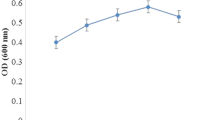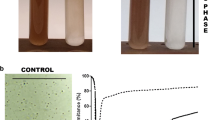Abstract
The majority of the existing water bodies around the world are increasingly polluted with oily wastewater. The aim of this study was to investigate the role of single protozoan isolates (Aspidisca, Trachelophyllum and Peranema) and of a consortium of these three protozoan isolates in the biodegradation of fats and oils present in polluted domestic wastewater. The biomass of protozoan isolates, chemical oxygen demand (COD), dissolved oxygen (DO) and concentrations of fats and oils were determined in triplicate before and after the inoculation of isolates in oily wastewaters, using standard methods. Results revealed optimum growth of protozoan cell densities under favourable conditions of 30 °C, pH 6 and 8 (from 1.00 to 4.00, 3.96, 3.80 and 4.20 × 102 cells/ml for Aspidisca, Trachelophyllum, Peranema and a consortium of the three isolates, respectively). The average percentage uptake of DO by Aspidisca, Trachelophyllum, Peranema and their consortium was 95, 96, 96 and 100 %, respectively, for both 30 and 25 °C and at pH levels of (4, 6, 8 and 10), respectively. The results revealed that the COD removal rates of the isolates at various pH levels were ≥20 and ≤90 %, respectively, for 30 and 25 °C. At a temperature of 30 °C, the biodegradation capabilities of the isolates ranged from 3.0 to 8.0, 3.0 to 6.0, 7.0 to 11.0 and 8.0 to 22.0 %, while at 25 °C, the biodegradation rates were 3.0 to 6.0, 4.0 to 7.0, 3.0 to 8.0 and 4.0 to 15.0 % for Aspidisca, Trachelophyllum, Peranema and the consortium of these three isolates, respectively.







Similar content being viewed by others
References
Akpor, O.B. (2009) The role of protozoa in the removal of phosphorus and nitrogen in activated sludge systems. D.Tech. Thesis, Tshwane University of Technology, Pretoria, South Africa.
Akpor, O. B., Momba, M. N. B., & Okonkwo, J. (2008). Effect of nutrient/carbon supplements on biological phosphate and nitrate uptake by protozoan isolates. Journal of Applied Sciences, 8(3), 489–495.
American Public Health Association (APHA). (2001) Standard methods for the examination of water and wastewater (20th edn.). Washington DC, USA.
Atlas, R. M. (1981). Microbial degradation of petroleum hydrocarbons, an environmental perspective. Microbiological Review, 45, 180–209.
Atlas, R. M., & Bartha, R. (1972). Biodegradation of petroleum in seawater at low temperatures. Canadian Journal of Microbiology, 18, 1851–1855.
Baheri, H., & Meysami, P. (2002). Feasibility of fungi bioaugmentation in composting a flare pit soil. Journal of Hazardous Materials, 89, 279–286.
Baig, A., Mohsin, M., Zafar, I., & Baig, M. (2003). Removal of oil and grease from industrial effluents. Electronic Journal of Environmental, Agricultural and Food Chemistry, 2(5), 577–585.
Bas, P., Archimede, H., Rouzeau, A., & Sauvant, D. (2003). Fatty acid composition of mixed-rumen bacteria: effect of concentration and type of forage. Journal of Dairy Science, 86, 2940–2948.
Berry, C. J., Story, S., Altman, D. J., Upchurch, R., Whitman, W., Singleton, D., Płaza, G., & Brigmon, R. L. (2000). Biological treatment of petroleum in radiologically contaminated soil. In C. J. Clark II & L. A. Stephenson (Eds.), Remediation of hazardous waste in the subsurface: bridging flask and field (p. 87). Washington, DC: American Chemical Society.
Borja, R., Banks, C. J., & Garrido, A. (1994). Kinetics of black-olive wastewater treatment by the activated sludge system. Process in Biochemistry, 29, 587–593.
Chikere, B. O., & Okpokwashi, G. C. (2004). Frequency of occurrence of micro-organisms at petrochemical effluents outfall site. Journal of Tropical Biosciences, 4, 12–18.
Colwell, R. E., & Walker, J. D. (1977). Ecological aspects of microbial degradation of petroleum in the marine environment. Critical Review Microbiology, 5, 423–445.
Dibble, J., & Bartha, R. (1979). Effect of environmental parameters on biodegradation of oil sludge. Applied Environmental Microbiology, 37(1979), 729–739.
Dua, M., Singh, A., Sethunathan, N., & Johri, A. K. (2002). Biotechnology and bioremediation: successes and limitations. Applied Microbiology Biotechnology, 59, 143–152. doi:10.1007/s00253-002-1024-6.
DWAF. (2004). Revision of general authorizations in terms of Section 39 of the National Water Act, 1998 (Act No. 36 of 1998). South African Government Gazette No 26187. Pretoria: Department of Water Affairs and Forestry.
Farrier-Pages, C., & Rassoulzadegan, F. N. (1994). Mineralization in planktonic protozoa. Limnology Oceanography, 39(2), 411–419.
Gutierrez, T., Shimmield, T., Haidon, C., Black, K., & Gree, D. H. (2008). Emulsifying and metal ion binding activity of a glycoprotein exopolymer produced by Pseudoalteromonas sp. strain TG12. Applied Environmental Microbiology, 74(15), 4867–4876.
Herman, D. C., & Maier, R. M. (2000). Physiological methods. In R. M. Maier, I. L. Pepper, & C. P. Gerba (Eds.), Environmental microbiology (pp. 235–265). New York: Academic.
Horowitz, A., Gutnick, D., & Rosenberg, E. (1975). Sequential growth of bacteria on crude oil. Applied Microbiology, 30, 10–19.
Kamika, I., & Momba, M. N. B. (2011). Comparing the tolerance limits of selected bacterial and protozoa species to vanadium in wastewater systems. Water Air Soil Pollution. doi:10.1007/s11270-011-1045-9.
Leahy, G. L., & Colwell, R. R. (1990). Microbial degradation of hydrocarbons in the environment. Microbiological Reviews, 54(3), 305–315.
Lefebvre, X., Paul, E., Mauret, M., Baptiste, P., & Capdeville, B. (1998). Kinetic characterization of saponified domestic lipid residues aerobic biodegradation. Water Research, 32, 3031–3038.
Masse, L., Kennedy, K., & Chou, S. (2001). Testing of alkaline and enzymatic hydrolysis pretreatments for fat particles in slaughterhouse wastewater. Bioresource Technology, 77, 145–155.
Mohammadi, T., & Esmaelifar, A. (2005). Journal of Membrane Science, 254, 129–137.
Momba, M. N. B., & Cloete, T. E. (1996). Biomass relationship to growth and phosphate uptake of Pseudomonas fluorescens, Escherichia coli and Acinetobacter radioresistens in mixed liquor medium. Journal of Industrial Microbiology, 16(6), 364–396.
Mongkolthanaruk, W., & Dharmsthiti, S. (2002). Biodegradation of lipid-rich wastewater by mixed bacterial consortium. International Biodeterioration and Biodegradation, 50, 101–105.
Peng, X., Murphy, T., & Holden, N. M. (2008). Evaluation of the effect of temperature on the die-off rate for Cryptosporidium parvum oocysts in water, soils and faeces. Applied Environmental Microbiology, 74(23), 7101–7107.
Petropoulos, P., & Gilbride, K. A. (2005). Nutrification in activated sludge batch reactors is linked to protozoan grazing of the bacterial population. Canadian Journal of Microbiology, 51, 791–799.
Płaza, G., Wypych, J., Berry, C., & Brigmon, R. L. (2007). Utilization of monocyclic aromatic hydrocarbons individually and in mixture by bacteria isolated from petroleum-contaminated soil. World Journal of Microbiology Biotechnology, 23, 533–542.
Płaza, G. A., Jangid, K., Lukasik, K., Nałecz-Jawecki, G., Berry, C., & Brigmon, R. L. (2008). Reduction of petroleum hydrocarbons and toxicity in refinery wastewater by bioremediation. Bulletin Environment Contamination Toxicity, 81, 329–333.
Rashid, M. M., Odongo, N. E., & McBride, B. W. (2007). Fatty acid composition of ruminal bacteria and protozoa, with emphasis on conjugated linoleic acid, vaccenic acid and odd-chain and branched-chain fatty acids. Journal of Animal Science, 85, 1228–1234.
Rogerson, A., & Berger, J. (1981). Effect of crude oil and petroleum-degrading microorganisms on the growth of fresh and soil protozoa. Journal of General Microbiology, 124, 53–59.
Saifudin, N., & Chua, K. H. (2006). Biodegradation of lipid-rich waste water by combination of microwave irradiation and lipase immobilized on chitosan. Biotechnology, 5(3), 315–323.
Sedlak, R. (1991). Phosphorous and nitrogen from municipal wastewater: principles and practice (2nd ed.). New York: Lewis.
Sherr, B. F., Sherr, E. B., & Berman, T. (1983). Grazing, growth and ammonium excretion rate of a heterotrophic microflagellate fed with four species of bacterial. Applied and Environmental Microbiology, 45(1983), 1196–1203.
Stams, A. J., & Elferink, S. J. (1997). Understanding and advancing treatment. Current Opinion in Biotechnology, 8, 328–334.
Van Beilen, J. B., & Funhoff, E. G. (2005). Expanding the alkane oxygenase toolbox: new enzymes and applications. Current Opinion in Biotechnology, 16(3), 308–314.
Wakelin, N. G., & Forster, C. F. (1997). An investigation into microbial removal of fats, oils and greases. Bioresource Technology, 59, 37–43.
Williams, A. G. (1986). Rumen holotrich ciliated protozoa. Microbiology Review, 50, 25–49.
Acknowledgments
The authors are grateful to the National Research Foundation (NRF) and Tshwane University of Technology (TUT) for their financial support.
Author information
Authors and Affiliations
Corresponding author
Rights and permissions
About this article
Cite this article
Kachieng’a, L.O., Momba, M.N.B. Biodegradation of Fats and Oils in Domestic Wastewater by Selected Protozoan Isolates. Water Air Soil Pollut 226, 140 (2015). https://doi.org/10.1007/s11270-015-2405-7
Received:
Accepted:
Published:
DOI: https://doi.org/10.1007/s11270-015-2405-7




